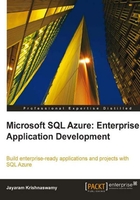
This book is about one of the components of the Windows Azure Platform that provides support for a relational database in the Cloud. However, as it is a component of a more comprehensive, larger system it is essential to understand how it is positioned in relation to the Windows Azure Platform. In addition to introducing the larger picture, the book also describes how Windows Azure cloud applications access and leverage relational data; how the business intelligence applications interact with the cloud-hosted relational data; how the relational database provides support for authenticating web clients; how the cloud and ground-based relational databases can be accessed from ground (on-site) as well as cloud applications, and many others.
The book, therefore, begins with an introduction to cloud computing as it is generally spoken about by reviewing the most popular cloud offerings and more specifically introduces the main components of Windows Azure Platform. Also included in this chapter is a section that you will need to go through before you access the Windows Azure Platform services.
In this chapter, we will look at the motivation for cloud computing. We will discuss the following:
- What is cloud computing?
- Why a business would like to move its business applications and data to the cloud
- Types of cloud services
- The hybrid cloud
- How cloud computing is implemented with examples of some major cloud computing vendors
- Windows Azure
Cloud computing is still evolving and perhaps one of the more enduring, all embracing, definition of cloud computing may be defined according to the NIST (http://csrc.nist.gov/nice/states/maryland/posters/cloud-computing.pdf)as follows:
"Cloud computing is a model for enabling convenient, on-demand network access to a shared pool of configurable computing resources that can be rapidly provisioned and released with minimal management effort or service provider interaction."
The resources, as it is implied here, would include not only the hardware but also the software that cloud computing would use.
The industry watchdog Gartner (http://www.gartner.com/it/page.jsp?id=1035013) on the other hand defines cloud computing as follows:
"Cloud computing is a style of computing where scalable and elastic IT-enabled capabilities are delivered as a service to external customers using Internet technologies."